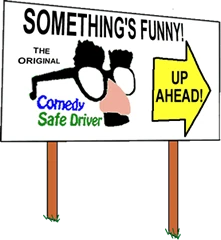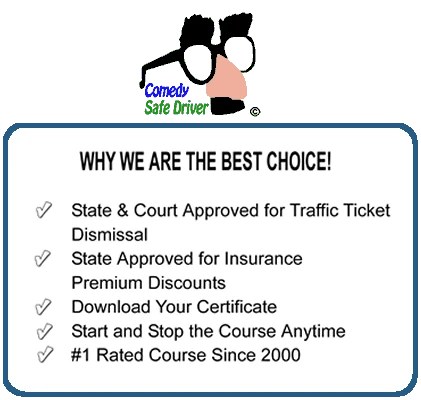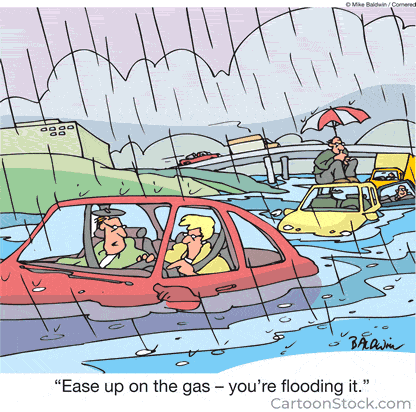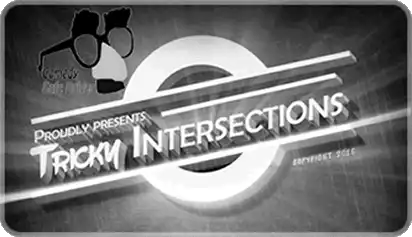
Defensive Driving Santa Fe NM
Welcome to the Comedy Safe Driver course in Santa Fe! If you're looking for an engaging and fun way to learn defensive driving techniques, you've come to the right place.
Why Choose Comedy Safe Driver in Defensive Driving Santa Fe NM?
Defensive Driving Santa Fe NM is not just about learning the rules of the road. It's about understanding how to anticipate potential hazards and react appropriately. Our course, with a touch of humor, ensures that you not only learn but also enjoy the process.
Safe Driving Tips
-
Understanding the Importance of a Safe Following Distance:
- The space between your vehicle and the one in front of you is more than just a gap; it's a safety buffer. This buffer is your reaction time, the period you have to assess a situation and respond appropriately. If the car ahead encounters an issue, such as a sudden stop due to an animal crossing or a pothole, having this distance can be the difference between a close call and a collision.
Factors Influencing the Ideal Following Distance:
-
Driving Conditions: As you mentioned, the ideal distance isn't static. On a clear, sunny day, the three-second rule might suffice. However, in adverse conditions like rain, fog, snow, or ice, the road becomes slippery, and visibility might be reduced. In such scenarios, extending the following distance to five seconds or more can provide added safety.
-
Vehicle Type: Larger vehicles like trucks or buses might require more distance to come to a complete stop compared to smaller cars. If you're driving behind a larger vehicle, it's wise to increase your following distance. Similarly, if you're driving a larger vehicle, be aware that you might need more space to stop safely.
-
Speed: As speed increases, so does the distance covered in a short span of time. At higher speeds, even a split-second delay in reaction can result in a significant distance covered without control. Hence, as speed increases, it's advisable to proportionally increase the following distance.
The Three-Second Rule and Its Application:
- This rule is a simple yet effective way to gauge a safe distance. When the rear of the vehicle passes a fixed point, like a signpost or a tree, start counting: "one-thousand-one, one-thousand-two, one-thousand-three." If the front of your vehicle passes the same point before you finish counting, you're too close and should ease off the accelerator to increase the gap.
Maintaining a safe following distance is a dynamic aspect of driving that requires constant attention and adjustment based on various factors. It's an essential practice that ensures not only your safety but also the safety of those around you on the road.
-
Understanding the Gravity of Distracted Driving:
- At its core, driving requires undivided attention. The road is an ever-changing environment with multiple variables, from other drivers and pedestrians to changing weather conditions and unexpected obstacles. When a driver's attention is diverted, even momentarily, it can have catastrophic consequences.
Types of Distractions:
-
Manual: These are distractions that cause you to take your hands off the wheel. Examples include texting, adjusting controls, or eating.
-
Visual: These take your eyes off the road. Glancing at a text message, looking at a GPS, or turning to talk to someone in the back seat are all visual distractions.
-
Cognitive: These take your mind off driving. Being lost in thought, daydreaming, or having a heated conversation can mentally distract you from the task at hand.
The Real Impact of a Few Seconds:
- Consider this: At 60 mph, in just 5 seconds (the average time it takes to read a text), a vehicle travels the length of a football field. That's a significant distance to cover blindfolded, and essentially, that's what happens when you're distracted.
Technological Distractions:
- Modern vehicles come equipped with a myriad of technological features, from infotainment systems to navigation aids. While they aim to enhance the driving experience, they can also be sources of distraction. It's crucial to familiarize oneself with these systems before setting off, so you can operate them with minimal distraction.
Steps to Minimize Distractions:
-
Prepare Before Driving: Set up your GPS, adjust your mirrors, and choose your playlist or radio station before you start driving.
-
Use Technology Wisely: If your car has voice-operated controls or hands-free calling, use these features to reduce manual and visual distractions.
-
Pull Over If Necessary: If you need to attend to something urgently, like answering a call or eating, it's safer to pull over to a safe spot and address it.
-
Educate Young Drivers: New drivers, especially teenagers, might be more susceptible to distractions due to their inexperience. It's vital to educate them about the dangers and set clear rules about phone use and other potential distractions while driving.
The road demands respect. Every time we get behind the wheel, we're not just responsible for our safety but also for the safety of others sharing the road with us. By understanding the risks associated with distractions and taking proactive measures to minimize them, we can make our journeys safer for everyone.
-
The Role of Turn Signals in Road Safety:
- Turn signals, often referred to as indicators, play a pivotal role in ensuring road safety. They act as the vehicle's way of "speaking" to other road users, signaling intentions and upcoming actions. By effectively using them, drivers can convey their plans, allowing others to anticipate and adjust their own actions accordingly.
Why Turn Signals Matter:
-
Predictability: On the road, predictability is a key factor in preventing accidents. When other drivers and pedestrians can anticipate your next move, they can act in a manner that avoids potential conflicts.
-
Reducing Ambiguity: Roads are filled with split-second decisions. By using turn signals, you reduce the guesswork for other drivers, making their decisions more informed.
-
Legal Requirement: In many jurisdictions, using turn signals is not just a safety recommendation but a legal requirement. Failing to use them can result in penalties or fines.
Best Practices for Using Turn Signals:
-
Timely Indication: It's essential to signal well in advance of making a turn or changing lanes. This gives other road users adequate time to understand your intentions and react if necessary.
-
Ensure Proper Functionality: Regularly check your turn signals to ensure they are functioning correctly. A malfunctioning signal can send wrong or confusing messages to other drivers.
-
Avoid Sending Mixed Signals: Ensure you turn off your signal after completing a turn or lane change. A lingering signal can confuse other drivers, making them think you intend to make another move.
-
Use Even When You Think It's Not Needed: Even if you believe no one is around, it's a good habit to use your signals. There might be someone you haven't noticed, like a pedestrian or a vehicle in your blind spot.
The Broader Context of Communication on the Road:
- Turn signals are just one aspect of vehicular communication. Brake lights, hazard lights, and even hand gestures (used legally and courteously) play roles in the dialogue between drivers. Understanding and effectively using these tools can significantly enhance road safety.
The simple act of using turn signals consistently and correctly can have a profound impact on road safety. It's a small gesture that carries significant weight, fostering an environment of mutual respect and understanding among all road users.
Safe driving is a responsibility every driver holds, not just for their safety but for the safety of others on the road as well. By adhering to these tips and being vigilant, we can contribute to making roads safer for everyone.
Defensive Driving Techniques in Defensive Driving Santa Fe NM
Defensive Driving: A Proactive Approach to Safety Defensive driving is all about being proactive rather than reactive. It's the practice of driving to save lives, time, and money, in spite of the conditions around you and the actions of others. Santa Fe, NM, with its unique road conditions and diverse weather patterns, requires drivers to be especially vigilant.
-
Anticipating Actions of Other Drivers:
- Why It's Important: Not every driver on the road will drive predictably or safely. By anticipating potential actions or mistakes of other drivers, you can be better prepared to react swiftly and safely.
- How to Practice: Always be on the lookout for signs that a driver might make a sudden move, such as swerving, erratic speeds, or not using turn signals. Also, be particularly cautious around commercial vehicles, as they have larger blind spots and require longer distances to stop.
-
Regular Use of Mirrors:
- Why It's Important: Your mirrors provide a panoramic view of what's happening behind and to the sides of your vehicle. Regularly checking them ensures you're not caught off-guard by vehicles approaching from behind or those in adjacent lanes.
- How to Practice: Make it a habit to glance at your rear-view mirror every 5-10 seconds and check your side mirrors before changing lanes or making turns. Adjust your mirrors properly before starting your journey to ensure maximum visibility.
-
Navigating Intersections Safely:
- Why It's Important: Intersections are hotspots for collisions. The "left-right-left" check ensures you've thoroughly scanned the intersection for oncoming traffic, pedestrians, and cyclists.
- How to Practice: As you approach an intersection, even if you have the right of way, slow down slightly. Look to the left first (as vehicles from this direction will reach you first), then to the right, and then back to the left before proceeding.
-
Driving Safely in Adverse Weather Conditions:
- Why It's Important: Santa Fe, NM, can experience a range of weather conditions, from rain to snow to fog. These conditions can reduce visibility and make roads slippery, increasing the risk of accidents.
- How to Practice: In addition to reducing speed, ensure your headlights are on (even during daylight in heavy rain or fog) to increase visibility. Avoid sudden maneuvers, and brake gently to prevent skidding. If you're driving in snow or icy conditions, consider using snow chains or winter tires for better traction.
Additional Tips for Santa Fe, NM:
- Due to the city's elevation and desert climate, Santa Fe can have cooler evenings even after warm days. This can sometimes lead to unexpected icy patches on the road, especially in shaded areas or bridges. Always be cautious in such conditions.
- Familiarize yourself with local traffic laws and regulations. Santa Fe might have specific rules that differ from other places.
Defensive driving is about being aware, prepared, and proactive. By mastering these techniques and adapting them to the specific conditions of Santa Fe, NM, drivers can ensure a safer driving experience for themselves and others on the road.
Join us at Comedy Safe Driver in Defensive Driving Santa Fe NM and become a safer driver while having a good laugh. Sign up today!
Contact Municipal Court
2511 Camino Entrada
Santa Fe, NM 87507
Main Line 505-955-5070
Fax 505-955-5159
Hours
8:00 a.m. - 5:00 p.m.
Monday - Friday
Payment Window
8:00 am - 4:00 pm
Monday - Friday















